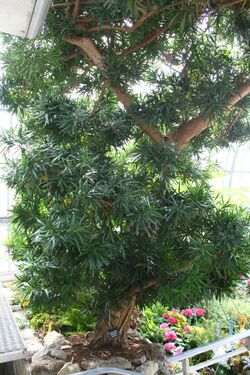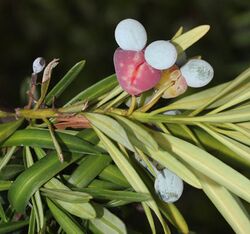Biology:Podocarpus macrophyllus
| Podocarpus macrophyllus | |
|---|---|

| |
| Scientific classification | |
| Kingdom: | Plantae |
| Clade: | Tracheophytes |
| Clade: | Gymnospermae |
| Division: | Pinophyta |
| Class: | Pinopsida |
| Order: | Araucariales |
| Family: | Podocarpaceae |
| Genus: | Podocarpus |
| Species: | P. macrophyllus
|
| Binomial name | |
| Podocarpus macrophyllus (Thunb.) Sweet
| |
Podocarpus macrophyllus is a conifer in the genus Podocarpus, family Podocarpaceae. It is the northernmost species of the genus, native to southern Japan and southern and eastern China . Common names in English include yew plum pine,[2] Buddhist pine, fern pine and Japanese yew.[3] Kusamaki (クサマキ) and inumaki (犬槇) are Japanese names for this tree. In China, it is known as luóhàn sōng (羅漢松), which literally means "arhat pine".
Description

It is a small to medium-sized evergreen tree, reaching 20 m (66 ft) tall.[4] The leaves are strap-shaped, 6–12 cm (2.4–4.7 in) long, and about 1 cm broad, with a central midrib. The cones are borne on a short stem, and have two to four scales, usually only one (sometimes two) fertile, each fertile scale bearing a single apical seed 10–15 mm. When mature, the scales swell up and become reddish purple, fleshy, and berry-like, 10–20 mm long; they are then eaten by birds, which disperse the seeds in their droppings.
P. macrophyllus occurs in forests, open thickets, and roadsides from near sea level to 1000 m above it.[4]
Symbolism, cultivation, and uses
Kusamaki is the state tree of Chiba Prefecture, Japan. It is a popular large shrub or small tree in gardens, particularly in Japan and the Southeastern United States. The ripe cone arils are edible, though the seed should not be eaten. Because of its resistance to termites and water, inumaki is used for quality wooden houses in Okinawa Prefecture, Japan.
Buddhist pine is highly regarded as a feng shui tree in Hong Kong, giving it a very high market value. In recent years, the illegal digging of Buddhist pine has become a problem in the city.[5]
This species can be trained as a bonsai.[6]
Gallery
-
From Flora Japonica by Philipp Franz von Siebold and Joseph Gerhard Zuccarini.
-
A closeup of the leaves.
-
Foliage with mature seed cones.
-
A trimmed P. macrophyllus.
References
- ↑ Farjon, A. (2013). "Podocarpus macrophyllus". IUCN Red List of Threatened Species 2013: e.T42517A2984343. doi:10.2305/IUCN.UK.2013-1.RLTS.T42517A2984343.en. https://www.iucnredlist.org/species/42517/2984343. Retrieved 12 November 2021.
- ↑ "Podocarpus macrophyllus". Natural Resources Conservation Service PLANTS Database. USDA. https://plants.usda.gov/core/profile?symbol=POMA32. Retrieved 9 October 2015.
- ↑ "Let's talk Japanese yews." Prosper Press. 15 January 2017. Retrieved 20 April 2022.
- ↑ 4.0 4.1 eFloras. "Podocarpus macrophyllus". Flora of China. Missouri Botanical Garden, St. Louis, MO & Harvard University Herbaria, Cambridge, MA. http://www.efloras.org/florataxon.aspx?flora_id=2&taxon_id=200005469.
- ↑ "Buddhist pine tree bandit jailed". https://www.news.gov.hk/isd/ebulletin/en/category/lawandorder/040831/html/040831en08002.htm.
- ↑ "Podocarpus Macrophyllus - Bonsai Empire". http://www.bonsaiempire.com/tree-species/podocarpus.
External links
- Gymnosperm Database: Podocarpus macrophyllus
- ITIS: Podocarpus macrophyllus[yes|permanent dead link|dead link}}]
- Seeds: Podocarpus macrophyllus
Wikidata ☰ Q165063 entry
 |





